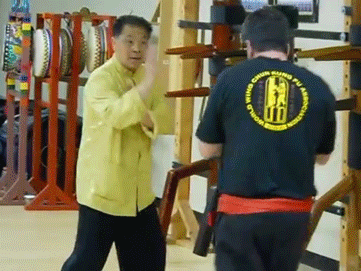The TWC method is to step out and circle around to the blindside, if possible. Call it a T-step or whatever, it maintains distance from the opponent by first stepping off to the side, away from them. This gives up space without physically affecting the opponent's ability to adjust with you in any way.
---It does not. The initial part of the step is laterally...the rear foot moving behind the lead foot....but that does not involve moving back away from the opponent. The lead shoulder and hip actually rotate towards the opponent.
As seen demonstrated by Cheung himself, his first reaction is to pull the rear foot backward, taking his body off to the side away from the opponent while intercepting the arm with a block.
---Just watch your own slo mo. Cheung is not increasing the distance between himself and the opponent with his step. He is only moving backwards some because his opponent is advancing towards him. This maintains his distance with the opponent. Then he steps forward and towards the opponent with his counter-attack.
From there, he intends to step his front foot out and around, advancing to the blindside. However, at this point absolutely nothing prevents the opponent from chasing center and cutting this step off while continuing to press the attack with another strike.
---Wrong again. His Pak Sau on the opponent's elbow is what prevents the opponent from turning to re-face his center with another strike. He then does a Lop Sau that uses his opponent's own forward momentum to throw him off-balance which definitely makes re-facing difficult!
---Interesting how you have edited this to suit your own conclusion. You cut it just before Cheung did the Pak Sau on the opponent's elbow that prevents him from tracking Cheung's step.
But, of course, in order to pull this next step off, the demo dummy has to freeze. No more stepping, no more attacking.
---Watch the video! He froze for a second because this is teaching clip. But that makes no difference. It works just as well at speed as it does in "teaching mode." Mazza threw a committed punch and his forward momentum was still carrying him forward. This wouldn't work against a fast and uncommitted jab, but that's not what Mazza was doing. And then Cheung did the Pak Sau and a Lop Sau that off-balanced him and that kept him from turning or re-facing easily. Look how Mazza is bent forward. And Cheung has zoned away from the second punch. Of course you edited all of that out of your version of the video. Just watch the actual video again:
https://www.youtube.com/watch?v=kFLqbtmmSwU
Cheung also makes 3 defensive actions on the posed punching arm and takes more steps before finally firing a return shot against this single punch.
---Yes. There are more steps involved. But you trade a few more movements done quickly that put you in a much safer relationship with the opponent compared to fewer movements that leave you standing in front of the opponent and still dealing with both of his arms. Just different tactics.
In reality, that arm will not be there after the first block, and the opponent won't just stand there. Another step and shot would be coming before Cheung takes his second step, interrupting this entire idea of getting around to the blindside like this.
--You are wrong. The opponent simply doesn't have time to pull that off. He has forward momentum to deal with, Cheung has moved completely away from his other punching arm, and Cheung is pressing his elbow with his Pak Sau to encourage his momentum to carry him in the and original direction and even turn him a bit. Its all in the video for anyone that cares to actually try and see what is happening.




 Reply With Quote
Reply With Quote

